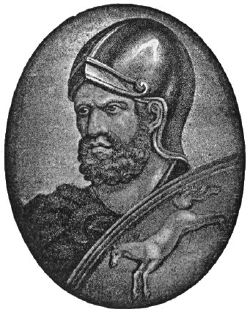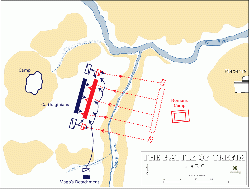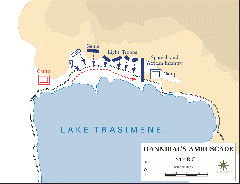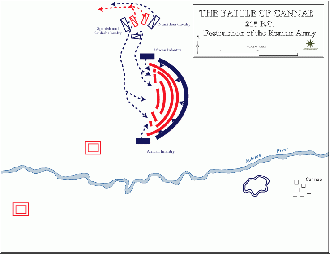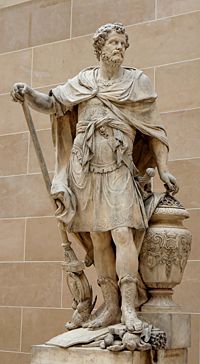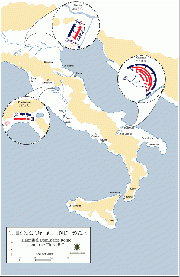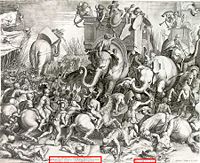Hannibal
Hannibal (247 B.C.E. â c. 183 B.C.E.)[1][2] (sometimes referred to as HÇnnibal Barca) was a Carthaginian politician and statesman who is popularly credited as one of the finest military commanders in history. He lived in a period of tension in the Mediterranean, with both Carthage and Rome (then the Roman Republic) vying for control of the region. Considered by many as the greatest hero of Carthage, he is best known for his achievements in the Second Punic War, when he marched an army, which famously included war elephants, from Iberia over the Pyrenees and the Alps into northern Italy.
During his invasion of Italy he defeated the Romans in a series of battles, out of which the most famous included the Battles of Trebia, Trasimene, and Cannae. After Cannae, he seized the second largest city in Italy, Capua, but he lacked the strength necessary to attack the city of Rome itself. He maintained an army in Italy for more than a decade afterward, never losing a major engagement, but never able to push the war through to a conclusion. During that period of time, the Roman armies regrouped. A Roman counter-invasion of North Africa forced him to return to Carthage, where he was defeated in the Battle of Zama. The defeat forced the Carthaginian Senate to send him into exile. During this exile, he lived at the Seleucid court, where he acted as military adviser to Antiochus III in his war against Rome. Defeated in a naval battle, Hannibal fled again, this time to the Bithynian court. When the Romans demanded his surrender, he preferred to commit suicide rather than submit.
Hannibal is universally ranked as one of the greatest military commanders and tacticians in history. Military historian Theodore Ayrault Dodge once famously christened Hannibal the "father of strategy"[3] for the reason that even his greatest enemy, Rome, came to adopt elements of his military tactics in their strategic canon.
Background and early career
Hannibal Barca ("mercy of Baal) was the son of Hamilcar Barca. It should be noted that Barca was an epithet, meaning "lightning" and not a surname. Historians refer to Hamilcar's family as the Barcids to avoid confusion with other Carthaginians of the same name. After Carthage's defeat in the First Punic War, Hamilcar set about the task of improving Carthage's fortunes. With that in mind, Hamilcar began the subjugation of the tribes of Spain. Carthage at the time was in such a poor state that its navy was unable to transport his army to Iberia (Hispania); instead, he had to march towards the Pillars of Hercules and ferry it across the strait. According to a story he later told at the court of Antiochus, Hannibal came upon his father while he was making a sacrifice to the gods before leaving for Hispania. Hannibal, then quite young, begged to go with him. Hamilcar agreed and forced Hannibal swear that as long as he lived he would never be a friend of Rome. Hannibal is reported to have told his father, "I swear so soon as age will permit⦠I will use fire and steel to arrest the destiny of Rome."[4] Some historians consider that Hannibal swore at the altar to Ba'al "never to be friend to Rome" (according to the more objective Polybius), and feel that "Barcid Rage" is mere post-war Roman opinion.
Hannibal's father went about the conquest of Hispania with all the skills given to military men. When he was killed in a battle, Hannibal's brother-in-law Hasdrubal succeeded to his command of the army. Hasdrubal pursued a policy of consolidation of Carthage's Iberian interests, even signing a treaty with Rome whereby Carthage would not expand past the Ebro River, so long as Rome did not expand south of it.
Upon the death of his brother-in-law (221 B.C.E.) Hannibal was acclaimed commander-in-chief by the army and confirmed in his appointment by the Carthaginian government. Titus Livy, a Roman scholar, gives a depiction of the young Carthaginian: âNo sooner had he arrived⦠the old soldiers fancied they saw Hamilcar in his youth given back to them; the same bright look; the same fire in his eye, the same trick of countenance and features. Never was one and the same spirit more skillful to meet opposition, to obey, or to commandâ¦â[5] After he assumed command, he spent two years consolidating his holdings and completing the conquest of Hispania south of the Ebro River. However, Rome, fearing the growing strength of Hannibal in Iberia, made an alliance with the city of Saguntum which lay a considerable distance south of the Ebro and claimed the city as its protectorate. Hannibal perceived this as a breach of the treaty signed with Hasdrubal and so he laid siege to the city, which fell after eight months. Rome was upset by this apparent violation of the treaty and demanded justice from Carthage. In view of Hannibal's great popularity, the Carthaginian government did not repudiate Hannibal's actions, and the war he sought was declared at the end of the year. Hannibal was now determined to carry the war into the heart of Italy by a rapid march through Hispania and southern Gaul (France).
Second Punic War in Italy (218â203 B.C.E.)
Overland Journey to Italy
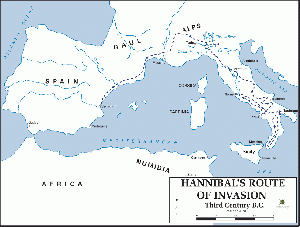
Hannibal departed New Carthage in late spring of 218 B.C.E. He fought his way through the northern tribes to the Pyrenees, subduing the tribes through clever mountain tactics and stubborn fighting. He left a detachment of 11,000 troops to garrison the newly conquered region. At the Pyrenees Mountains, he released another 11,000 Iberian troops who showed reluctance to leave their homeland. Hannibal reportedly entered Gaul with 50,000 foot soldiers and 9,000 horsemen.
Hannibal recognized that he still needed to cross the Pyrenees, the Alps, and many significant rivers. Additionally, he would have to contend with opposition from the Gauls, whose territory he passed through. Starting in the spring of 218 B.C.E., he easily fought his way through the northern tribes to the Pyrenees and, by conciliating the Gaulish chiefs along his passage, reached the Rhône River before the Romans could take any measures to bar his advance. Arriving at the Rhône in September, Hannibal's army numbered 38,000 infantry, 8,000 cavalry, and thirty-seven war elephants.
After outmaneuvering the natives, who had tried to prevent his crossing, Hannibal evaded a Roman force sent to operate against him in Gaul. He then proceeded up the valley of one of the tributaries of the Rhône River and by autumn arrived at the foot of the Alps. His passage over the Alps is one of the most celebrated achievements of any military force in ancient warfare. Hannibal successfully crossed the mountains, despite numerous obstacles such as harsh climate and terrain, the Guerrilla warfare tactics of the native tribes, and the challenge of commanding an army diverse in race and language. He descended from the foothills and arrived into northern Italy, but accompanied by only half the forces he had started with, and only a few elephants. From the start it appears that he calculated operating without aid from Hispania.
Battle of Trebia
Hannibal's perilous march brought him into Roman territory and frustrated the attempts of the enemy to fight out the main issue on foreign ground. His sudden appearance among the Gauls of the Po Valley, moreover, enabled him to detach those tribes from their new allegiance to the Romans before the latter could take steps to check the rebellion.
Publius Cornelius Scipio, the consul who commanded the Roman force sent to intercept Hannibal, had not expected Hannibal to make an attempt to cross the Alps, since the Romans were prepared to fight the war in Spain. With a small detachment still positioned in Gaul, Scipio made an attempt to intercept Hannibal. Through prompt decision and speedy movement, he succeeded in transporting his army to Italy by sea, in time to meet Hannibal. After allowing his soldiers a brief rest to recover from their exertions, Hannibal first secured his rear by subduing the hostile tribe of the Taurini (modern Turin). While moving down the Riber Po Valley, the opposing forces were engaged in a small confrontation at Ticinus. Here, Hannibal forced the Romans, by virtue of his superior cavalry, to evacuate the plain of Lombardy. This victory, though essentially a minor engagement, did much to weaken Roman control over the Gauls. As a result of Romeâs defeat at Ticinus, the Gauls were encouraged to join the Carthaginian cause. Soon the entirety of northern Italy was unofficially allied, both Gallic and Ligurian troops soon bolstering his army back to 40,000 men. Hannibalâs army, significantly supplemented, now stood poised to invade Italy. Scipio, severely injured in the battle, retreated across the River Trebia with his army still intact, and encamped at the town of Placentia to await reinforcements.
The other Roman consular army was rushed to the Po Valley. Even before news of the defeat at Ticinus had reached Rome, the senate had ordered the consul Sempronius Longus to bring his army back from Sicily to meet Scipio and face Hannibal. Hannibal, by skillful maneuvers, was in position to head him off, for he lay on the direct road between Placentia and Arminum, by which Sempronius would have to march in order to reinforce Scipio. He then captured Clastidium, from which he drew large amounts of rations for his men. But this gain was not without its loss, as Sempronius avoided Hannibal's watchfulness, slipped around his flank, and joined his colleague in his camp near the Trebbia River near Placentia. There, in December of the same year, Hannibal had an opportunity to show his superior military skill at Trebia; after wearing down the excellent Roman infantry he cut it to pieces by a surprise attack from an ambush in the flank.
Battle of Lake Trasimene
Having secured his position in northern Italy by this victory, Hannibal quartered his troops for the winter with the Gauls, whose support for him abated. In the spring of 217 B.C.E. Hannibal decided to find a more reliable base of operations farther south. Expecting Hannibal to carry on advancing to Rome, Cnaeus Servilius and Gaius Flaminius (the new Consuls of Rome) took their armies to block the Eastern and Western routes Hannibal could use to get to Rome.
The only alternate route to central Italy lay at the mouth of the Arno. This route was practically one huge marsh, and happened to be overflowing more than usual during this particular season. Hannibal knew that this route was full of difficulties, but it remained the surest and certainly the quickest route to Central Italy. Polybius claims that four days and three nights Hannibalâs men marched âthrough a route which was under waterâ suffering terribly from fatigue and enforced lack of sleep.[6] He crossed the Apennines (during which he lost one of his eyes because of conjunctivitis) and the seemingly impassable Arno River without opposition, but in the marshy lowlands of the Arno, he lost a large part of his force, including, it would seem, his remaining elephants.
Arriving in Eturia in the spring of 217 B.C.E., Hannibal decided to lure the main Roman army under Flaminius into a pitched battle, by devastating under his very own eye the area he had been sent to protect. At the same time, he tried to break the allegiance of Romeâs allies, by proving that Rome was powerless to protect them. Despite this, Hannibal found Flaminius still passively encamped at Arretium. Unable to draw Flaminius into battle by mere devastation, Hannibal marched boldly around his opponentâs left flank and effectively cut Flaminius off from Rome (thus executing the first conscious turning movement in military history). Advancing through the uplands of Etruria, Hannibal provoked Flaminius to a hasty pursuit and, catching him in a defile on the shore of Lake Trasimenus, destroyed his army in the waters or on the adjoining slopes while killing Flaminius as well. He had now disposed of the only field force which could check his advance upon Rome, but, realizing that without siege engines he could not hope to take the capital, he preferred to exploit his victory by passing into central and southern Italy and encouraging a general revolt against the sovereign power. After Lake Trasimene, Hannibal stated, âI have not come to fight Italians, but on behalf of the Italians against Rome.â[7]
The Romans appointed Fabius Maximus as a dictator. Departing from Roman military traditions, he adopted the Fabian strategy of refusing open battle with his opponent while placing several Roman armies in Hannibalâs vicinity to limit his movement.
Having ravaged Apulia without provoking Fabius to battle, Hannibal decided to march through Samnium to Campania, one of the richest and most fertile provinces of Italy, hoping that the devastation would draw Fabius into battle. Fabius closely followed Hannibalâs path of destruction, yet still refused to let himself be drawn into battle, and thus remained on the defensive. This strategy was unpopular with many Romans who believed it was a form of cowardice.
As the year wore on, Hannibal decided that it would be unwise to winter in the already devastated lowlands of Campania but Fabius had ensured that all the passes out of Campania were blocked. To avoid this, Hannibal deceived the Romans into thinking that the Carthaginian Army was going to escape through the woods. As the Romans moved off towards the woods, Hannibal's army occupied the pass, and his army made their way through the pass unopposed. Fabius was within striking distance but in this case his caution worked against him. Smelling a stratagem (rightly) he stayed put. For the winter, Hannibal found comfortable quarters in the Apulian plain. Hannibal's achievement in extricating his army shows his mastery of strategy at its best. This was a severe blow to Fabiusâs prestige, and soon after this, his period of power ended.
Battle of Cannae
In the Spring of 216 B.C.E. Hannibal took the initiative and seized the large supply depot at Cannae in the Apulian plain. Thus, by seizing Cannae, Hannibal had placed himself between the Romans and their crucial source of supply. Once the Roman Senate resumed their Consular elections in 216, they appointed Caius Terentius Varro and Lucius Aemilius Paullus as Consuls. In the meantime, the Romans, hoping to gain success through sheer strength in numbers, raised a new army of unprecedented size, estimated by some to be as large as 100,000 men.
The Roman and Allied legions of the Consuls, resolving to confront Hannibal, marched southward to Apulia. They eventually found him on the left bank of the Audifus River, and encamped six miles away. On this occasion, the two armies were combined into one, the Consuls having to alternate their command on a daily basis. The Consul Varro, who was in command on the first day, was a man of reckless and hubristic nature, and was determined to defeat Hannibal. Hannibal capitalized on the eagerness of Varro and drew him into a trap by using an envelopment tactic which eliminated the Roman numerical advantage by shrinking the surface area where combat could occur. Hannibal drew up his least reliable infantry in a semicircle in the center with the wings composed of the Gallic and Numidian horse. The Roman legions forced their way through Hannibal's weak center but the Libyan Mercenaries in the wings swung around by the movement, menaced their flanks. The onslaught of Hannibal's cavalry was irresistible, and Hasdrubal, his brother, who commanded the left, pushed in the Roman right and then swept across the rear and attacked Varro's cavalry on the Roman left. Then he attacked the legions from behind. As a result, the Roman army was hemmed in with no means of escape.
Due to these brilliant tactics, Hannibal, with much inferior numbers, managed to surround and destroy all but a small remainder of this force. Depending upon the source, it is estimated that 50,000-70,000 Romans were killed or captured at Cannae. Among the dead were the Roman consul Lucius Aemilius Paullus, as well two consuls for the preceding year, two quaestors, twenty-nine out of the forty-eight military tribunes, and an additional eighty senators (at a time when the Roman Senate was comprised of no more than 300 men, this constituted 25â30 percent of the governing body). This makes the Battle of Cannae one of the most catastrophic defeats in the history of Ancient Rome, and one of the bloodiest battles in all of human history (in terms of the number of lives lost within a single day). After Cannae, the Romans refused to fight Hannibal in pitched battles, aiming instead to defeat him by attrition, relying on their advantages of supply and manpower.
The effect on morale of this victory meant that most of southern Italy joined Hannibal's cause. As Polybius notes, âHow much more serious was the defeat of Cannae, than those which preceded it can be seen by the behavior of Romeâs allies; before that fateful day, their loyalty remained unshaken, now it began to waver for the simple reason that they despaired of Roman Power.â[8] During that same year, the Greek cities in Sicily were induced to revolt against Roman political control, while the Macedonian king, Philip V pledged his support to Hannibalâthus initiating the First Macedonian War against Rome. Hannibal also secured an alliance with newly appointed King Hieronymous of Syracuse, Italy. Had Hannibal now received proper material reinforcements from his countrymen at Carthage he might have made a direct attack upon Rome; for the present he had to content himself with subduing the fortresses which still held out against him, and the only other notable event of 216 B.C.E. was the defection of Capua, the second largest city of Italy, which Hannibal made his new base. Yet even this defection failed to satisfy him as only a few of the Italian city-states which he had expected to gain as allies consented to join him.
Stalemate
The war in Italy settled into a strategic stalemate. The Romans utilized the attritional strategies Fabius had taught them, and which, they finally realized, were the only feasible means of defeating Hannibal. The Romans deprived Hannibal of a large-scale battle and instead, assaulted his weakening army with multiple smaller armies in an attempt to both weary him and create unrest in his troops. "This was just what gave Hannibal the greatest trouble," says Dodge, because "it deprived him of the possibility of winning victories."[9] For the next few years, Hannibal was forced to sustain a scorched earth policy and obtain local provisions for protracted and ineffectual operations throughout Southern Italy. His immediate objectives were reduced to minor operations which centered mainly round the cities of Campania.
Hannibal repeatedly appealed to the Carthaginian oligarchy for reinforcements and aid. Despite the apparent unanimity of the acceptance of war, Hanno the Great, the leader of the pro-Roman Peace Party, condemned Hannibalâs actions. While Hannibal desperately required reinforcements in Italy, Carthaginian troops were directed towards Iberia (Carthage's main source of wealth in the Mediterranean), which the Romans were successful in attacking. His men grew increasingly weak beyond the point where he was no longer able to beat the Romans.
As the forces detached under his lieutenants were generally unable to hold their own, and neither his home government nor his new ally Philip V of Macedon helped to make good his losses, his position in southern Italy became increasingly difficult and his chance of ultimately conquering Rome grew ever more remote. Hannibal still won a number of notable victories: completely destroying two Roman armies in 212 B.C.E., and at one point, killing two Consuls (which included the famed Marcus Claudius Marcellus) in a battle in 208 B.C.E. Nevertheless, without the resources his allies could contribute, or reinforcements from Carthage, Hannibal could not make further significant gains. Thus, inadequately supported by his Italian allies, abandoned by his government, and unable to match Romeâs resources, Hannibal slowly began losing ground. Hannibal continued defeating the Romans whenever he could bring them into battle, yet he was never able to complete another decisive victory that produced a lasting strategic effect.
End of War in Italy
In 212 B.C.E. Hannibal captured Tarentum but he failed to obtain control of the harbor. The tide was slowly turning towards Rome.
The Romans mounted two sieges of Capua, which fell in 211 B.C.E., and the Romans completed their conquest of Syracuse and destruction of a Carthaginian army in Sicily. Shortly thereafter, the Romans pacified Sicily and entered into an alliance with the Aetolian League to counter Phillip V. Philip, who attempted to exploit Rome's preoccupation in Italy to conquer Illyria, now found himself under attack from several sides at once and was quickly subdued by Rome and her Greek allies. Meanwhile, Hannibal had defeated Fulvius at Herdonea in Apulia, but lost Tarentum in the following year.
In 210 B.C.E. Hannibal again proved his superiority in tactics by a severe defeat inflicted at Herdoniac (modern Ordona) in Apulia upon a proconsular army, and in 208 B.C.E. destroyed a Roman force engaged in the siege of Locri Epizephyri. But with the loss of Tarentum in 209 B.C.E. and the gradual reconquest by the Romans of Samnium and Lucania, his hold on south Italy was almost lost. In 207 B.C.E. he succeeded in making his way again into Apulia, where he waited to concert measures for a combined march upon Rome with his brother Hasdrubal Barca. On hearing, however, of his brother's defeat and death at the Metaurus he retired into Bruttium, where he maintained himself for the ensuing years. The combination of these events marked the end to Hannibal's success in Italy. With the failure of his brother Mago Barca in Liguria (205 B.C.E.-203 B.C.E.) and of his own negotiations with Philip of Macedon, the last hope of recovering his ascendancy in Italy was lost. In 203 B.C.E., after nearly fifteen years of fighting in Italy, and with the military fortunes of Carthage rapidly declining, Hannibal was recalled to Carthage to direct the defense of his native country against a Roman invasion under Scipio Africanus.
Conclusion of Second Punic War (203â201 B.C.E.)
Return to Carthage
In 203 B.C.E., when Scipio was carrying all before him in Africa and the Carthaginian peace party were arranging an armistice, Hannibal was recalled from Italy by the war party at Carthage. After leaving a record of his expedition engraved in Punic and Greek upon brazen tablets in the temple of Juno at Crotona, he sailed back to Africa. His arrival immediately restored the predominance of the war party, who placed him in command of a combined force of African levies and his mercenaries from Italy. In 202 B.C.E., Hannibal met Scipio in a fruitless peace conference. Despite mutual admiration, negotiations floundered due to Roman allegations of "Punic Faith," referring to the breach of protocols which ended the First Punic War by the Carthaginian attack on Saguntum, as well as perceived breach in contemporary military etiquette (Hannibal's numerous ambuscades). The decisive battle at Zama soon followed.
Battle of Zama
Unlike most battles of the Second Punic War, the Romans had superiority in cavalry and the Carthaginians had superiority in infantry. This Roman cavalry superiority was due to the betrayal of Masinissa, who despite assisting Carthage in Spain, changed sides in 206 B.C.E. with the promise of land (also due to his personal conflicts with Syphax, who sided with the Carthaginians). This betrayal gave Scipio Africanus an advantage that had previously been possessed by the Carthaginians. The aging Hannibal was suffering from mental exhaustion and deteriorating health after years of campaigning in Italy. However, the Carthaginians still had the advantage in numbers and were boosted by the presence of 80 war elephants.
The Roman cavalry won an early victory, and Scipio had devised tactics for defeating Carthaginian war elephants. However, the battle remained closely fought, and at one point it seemed that Hannibal was on the verge of victory. However, Scipio was able to rally his men, and his cavalry attacked Hannibal's rear. This two-pronged attack caused the Carthaginian formation to disintegrate and collapse. With their foremost general defeated, the Carthaginians had no choice but to accept defeat and surrender to Rome. Carthage lost approximately 31,000 troops with an additional 15,000 being wounded. The Romans suffered only 1500 casualties. The battle resulted in a loss of respect for Hannibal by his fellow Carthaginians. It marked the last major battle of the Second Punic War, with Rome the victors. The conditions of defeat were such that Carthage could no longer battle for Mediterranean supremacy. However, Hannibal has still been glorified despite this loss due to the fact that Scipio had used Hannibal's tactics to defeat him.
Later career
Peacetime Carthage (200â196 B.C.E.)
Hannibal was still only in his forty-sixth year and soon showed that he could be a statesman as well as a soldier. Following the conclusion of a peace that left Carthage stripped of its formerly mighty empire Hannibal prepared to take a back seat for a time. However, the blatant corruption of the oligarchy gave Hannibal a chance of a come back and he was elected as suffet, or chief magistrate. The office had become rather insignificant, but Hannibal restored its power and authority. The oligarchy, always jealous of him, had even charged him with having betrayed the interests of his country while in Italy, for neglecting to take Rome when he might have done so. So effectively did Hannibal reform abuses that the heavy tribute imposed by Rome could be paid by installments without additional and extraordinary taxation. He also reformed the Council of One Hundred, stipulating that its membership be chosen by direct election rather than co-option.
Exile and death (195â183 B.C.E.)
Seven years after the victory of Zama, the Romans, alarmed by Carthage's renewed prosperity, demanded Hannibal's surrender. Hannibal thereupon went into voluntary exile. First he journeyed to Tyre, the mother-city of Carthage, and then to Ephesus, where he was honorably received by Antiochus III of Syria, who was preparing for war with Rome. Hannibal soon saw that the king's army was no match for the Romans. He advised him to equip a fleet and land a body of troops in the south of Italy, offering to take command himself. But he could not make much impression on Antiochus, who listened to his courtiers and would not entrust Hannibal with any important office.
According to Cicero, while at the court of Antiochus, Hannibal attended a lecture by Phormio, a philosopher, that ranged through many topics. When Phormio finished a discourse on the duties of a general, Hannibal was asked his opinion. He replied: "I have seen during my life many an old fool; but this one beats them all." Another story about Hannibal in exile gives a strange slant to his supposed Punic perfidy. Antiochus III showed off a vast and well-armed formation to Hannibal and asked him if they would be enough for the Roman Republic, to which Hannibal replied, "Yes, enough for the Romans, however greedy they may be."
In 190 B.C.E. he was placed in command of a Phoenician fleet but was defeated in a battle off the Eurymedon River. According to Strabo and Plutarch, Hannibal also received hospitality at the Armenian court of Artaxias I where he planned and supervised the building of the new royal capital Artaxata. From the court of Antiochus, who seemed prepared to surrender him to the Romans, Hannibal fled to Crete, but he soon went back to Asia Minor and sought refuge with Prusias I of Bithynia, who was engaged in warfare with Rome's ally, King Eumenes II of Pergamum. Hannibal went on to serve Prusias in this war. In one of the victories he gained over Eumenes at sea, it is said that he used one of the first examples of biological warfareâhe threw cauldrons of snakes into the enemy vessels. Once more the Romans were determined to hunt him down, and they sent Flaminius to insist on his surrender. Prusias agreed to give him up, but Hannibal was determined not to fall into his enemies' hands. At Libyssa on the eastern shore of the Sea of Marmora, he took poison, which, it was said, he had long carried about with him in a ring. The precise year of his death is a matter of controversy. If, as Livy seems to imply, it was 183 B.C.E., he died in the same year as Scipio Africanus at the age of sixty four.
Legacy
Long after his death, his name continued to carry a portent of great or imminent danger within the Roman Republic. It was written that he taught the Romans, who claimed to be fierce descendants of Mars, the meaning of fear. For generations, Roman housekeepers would tell their children brutal tales of Hannibal when they misbehaved (the equivalent of the modern day "Bogeyman"). In fact, Hannibal became such a figure of terror, that whenever disaster struck, the Roman Senators would exclaim "Hannibal ad portas" (âHannibal is at the Gates!â) to express their fear or anxiety. This famous Latin phrase evolved into a common expression that is often still used when a client arrives through the door or when one is faced with calamity.[10] This illustrates the psychological impact Hannibal's presence in Italy had on Roman Culture.
Most of the sources available to historians about Hannibal are Romans, who considered him the greatest enemy they had ever faced. Livy gives us the idea that he was extremely cruel. Even Cicero, when he talked of Rome and her two great enemies, spoke of the "honorable" Pyrrhus and the "cruel" Hannibal. Yet a different picture is sometimes revealed. When Hannibal's successes had brought about the death of two Roman consuls, he vainly searched for the body of Gaius Flaminius on the shores of Lake Trasimene, held ceremonial rituals in recognition of Lucius Aemilius Paullus, and sent Marcus Claudius Marcellus' ashes back to his family in Rome. Any bias attributed to Polybius, however, is more troublesome, since he was clearly sympathetic towards Hannibal. Nevertheless, Polybius spent a long period as a hostage in Italy and relied heavily on Roman sources, so there remains the possibility that he was reproducing elements of Roman propaganda.
Hannibal continues to enjoy a strong reputation in the modern world. He was regarded as a "gifted strategist" by men like Napoleon Bonaparte and Arthur Wellesley. He has also been the basis for a number of films and documentaries.
Literature
Novel unless otherwise noted
- 1300s, Dante's Divine Comedy, poem, Inferno XXXI.97-132, 115-124 (Battle of Zama) and Paradiso VI. Online edition at The Divine Comedy Retrieved August 21, 2007.
- 1700s, Gulliver's Travels, satirical work. See critical edition, NY: W. W norton, 2002. ISBN 9780393957242.
- 1862, Gustave Flaubert's Salammbô, set in Carthage at the time of Hamilcar Barca. Hannibal appears as a child. NY: Penguin, 1977. ISBN 9780140443288.
- 1996, Elisabeth Craft, A Spy for Hannibal: A Novel of Carthage. Laurel, MD: Bartleby Press. ISBN 091015533X.
- Ross Leckie, Carthage trilogy, source of the 2006 film (1996, Hannibal: A Novel, ISBN 0895264439; 1999, Scipio, a Novel, ISBN 034911238X; Carthage, 2000, ISBN 0862419441)
- 2005, Terry McCarthy, The Sword of Hannibal. ISBN 044661517X.
- 2006, David Anthony Durham, Pride of Carthage: A Novel of Hannibal, NY: Doubleday ISBN 0385722494.
- 2006, Angela Render, Forged By Lightning: A Novel of Hannibal and Scipio. ISBN 1411680022.
Theater and opera
- In Berlioz's Les Troyens, he appears in a vision to Dido just before she dies.
Military history
Hannibal's legacy extends to the field of military history, as he is universally ranked as one of the greatest military strategists and tacticians of the Western world, alongside Alexander the Great, Julius Caesar, Robert E. Lee, Erwin Rommel, Napoleon Bonaparte, and Frederick the Great among others. In fact, his exploits (especially his victory at Cannae) continue to be studied in several military academies all over the world.
The author of the 1911 Encyclopædia Britannica article praises Hannibal in these words:
As to the transcendent military genius of Hannibal there cannot be two opinions. The man who for fifteen years could hold his ground in a hostile country against several powerful armies and a succession of able generals must have been a commander and a tactician of supreme capacity. In the use of stratagems and ambuscades he certainly surpassed all other generals of antiquity. Wonderful as his achievements were, we must marvel the more when we take into account the grudging support he received from Carthage. As his veterans melted away, he had to organize fresh levies on the spot. We never hear of a mutiny in his army, composed though it was of Africans, Spaniards and Gauls. Again, all we know of him comes for the most part from hostile sources. The Romans feared and hated him so much that they could not do him justice. Livy speaks of his great qualities, but he adds that his vices were equally great, among which he singles out his more than Punic perfidy and an inhuman cruelty. For the first there would seem to be no further justification than that he was consummately skillful in the use of ambuscades. For the latter there is, we believe, no more ground than that at certain crises he acted in the general spirit of ancient warfare. Sometimes he contrasts most favorably with his enemy. No such brutality stains his name as that perpetrated by Claudius Nero on the vanquished Hasdrubal. Polybius merely says that he was accused of cruelty by the Romans and of avarice by the Carthaginians. He had indeed bitter enemies, and his life was one continuous struggle against destiny. For steadfastness of purpose, for organizing capacity and a mastery of military science he has perhaps never had an equal.
Even his Roman chroniclers acknowledged his military genius, writing that, "he never required other to do what he could and would not do himsel."[12] Napoleon Bonaparte regarded Hannibal as a gifted strategist, describing him as "the most audacious of all, probably the most stunning, so hardy, so sure, so great in all things." Alfred Graf von Schlieffenâs eponymously-titled Schlieffen Plan was developed from his military studies, with particularly heavy emphasis on Hannibal's victory at Cannae. George S. Patton believed that he was a reincarnation of General Hannibal.
After his defeat, Hannibal reportedly met Scipio Africanus while in the court of Antiochus: the two mortal enemies conversed amicably and Scipio asked Hannibal his opinion on who the greatest military mind of all time was. Hannibal said, "Alexander the Great." Scipio then asked him who was the second. "Pyrrhus of Epirus," said Hannibal. Scipio asked why he, who defeated Hannibal, was not included, and Hannibal replied that this did not change his opinion, except that if Hannibal had defeated Scipio, he would then have ranked first, ahead of Alexander the Great.
According to the military historian, Theodore Ayrault Dodge,
Hannibal excelled as a tactician. No battle in history is a finer sample of tactics than Cannae. But he was yet greater in logistics and strategy. No captain ever marched to and fro among so many armies of troops superior to his own numbers and material as fearlessly and skillfully as he. No man ever held his own so long or so ably against such odds. Constantly overmatched by better soldiers, led by generals always respectable, often of great ability, he yet defied all their efforts to drive him from Italy, for half a generation. Excepting in the case of Alexander, and some few isolated instances, all wars up to the Second Punic War, had been decided largely, if not entirely, by battle-tactics. Strategic ability had been comprehended only on a minor scale. Armies had marched towards each other, had fought in parallel order, and the conqueror had imposed terms on his opponent. Any variation from this rule consisted in ambuscades or other stratagems. That war could be waged by avoiding in lieu of seeking battle; that the results of a victory could be earned by attacks upon the enemyâs communications, by flank-maneuvers, by seizing positions from which safely to threaten him in case he moved, and by other devices of strategy, was not understood ⦠[However] For the first time in the history of war, we see two contending generals avoiding each other, occupying impregnable camps on heights, marching about each other's flanks to seize cities or supplies in their rear, harassing each other with small-war, and rarely venturing on a battle which might prove a fatal disasterâall with a well-conceived purpose of placing his opponent at a strategic disadvantageâ¦. That it did so was due to the teaching of Hannibal.[13]
Notes
- â Hannibal's date of death is most commonly given as 183 B.C.E., but there is a possibility it could have taken place in 182 B.C.E.
- â Church, 269.
- â Dodge (1995), 247.
- â Reverse Spins, Patton, the Second Coming of Hannibal. Retrieved August 21, 2007.
- â Livy, The History of Rome: Vol III. Retrieved August 21, 2007.
- â Polybius, The Histories of Polybius, 2 Vols., trans. Evelyn S. Shuckburgh (London: Macmillan, 1889), I. 264-275
- â James Parker, USAWC Comparing Strategies of the 2nd Punic War. Retrieved August 21, 2007.
- â Polybius, op cit
- â Dodge, 315.
- â Alan Emrich, Practical Latin. Retrieved August 21, 2007.
- â Hannibal, Carthaginian General from 1911 Encyclopædia Britannica.
- â CarpeNoctem.tv, Hannibal. Retrieved August 21, 2007.
- â Dodge, 652.
ReferencesISBN links support NWE through referral fees
- Bradford, E. Hannibal. London: Macmillan London Ltd., 1981.
- Caven, B. Punic Wars. London: George Werdenfeld and Nicholson Ltd., 1980. ISBN 0312655800.
- Church, Alfred John, and Arthur Gilman. The Story of Carthage. New York: G.P. Putnam's Sons, 1886.
- Cottrell, Leonard. Hannibal: Enemy of Rome. Cambridge, MA: Da Capo Press, 1992. ISBN 0306804980.
- Daly, Gregory. Cannae: The Experience of Battle in the Second Punic War. New York: Routledge, 2002. ISBN 0415327431.
- Delbrück, Hans. Warfare in Antiquity. Lincoln: University of Nebraska Press, 1990. ISBN 0-8032-9199-X.
- Dodge, Theodore Ayrault. Hannibal: A History of the Art of War Among the Carthaginians and Romans Down to the Battle of Pydna, 168 B.C.E., with a Detailed Account of the Second Punic War. New York: Da Capo Press, 1995. ISBN 9780306806544.
- Hoyos, Dexter. Hannibal's Dynasty: Power and Politics in the Western Mediterranean, 247â183 B.C.E. London: Routlege, 2003.
- Hoyos, Dexter. Hannibal: Rome's Greatest Enemy. Bristol: Phoenix Press, 2005. ISBN 1904675468.
- Lamb, Harold. Hannibal: One Man Against Rome. Garden City, NY: Doubleday, 1959.
- Livy, Titus Livius, and Aubery De Selincourt. The War with Hannibal: Books XXI-XXX of the History of Rome from its Foundation. New York: Penguin Classics, 1965. ISBN 014044145X.
- Prevas, John. Hannibal Crosses the Alps. Cambridge: MAL Da Capo Press, 2001. ISBN 0306810700.
- Talbert, Richard J.A. (ed.). Atlas of Classical History. New York: Routledge, 1985. ISBN 0-415-03463-9.
- Yardley, J.C. (trans.). & D. Hoyos. Livy: Hannibal's War: Books 21 to 30. Oxford: Oxford Univ. Press, 2006, ISBN 9780192831590.
Credits
New World Encyclopedia writers and editors rewrote and completed the Wikipedia article in accordance with New World Encyclopedia standards. This article abides by terms of the Creative Commons CC-by-sa 3.0 License (CC-by-sa), which may be used and disseminated with proper attribution. Credit is due under the terms of this license that can reference both the New World Encyclopedia contributors and the selfless volunteer contributors of the Wikimedia Foundation. To cite this article click here for a list of acceptable citing formats.The history of earlier contributions by wikipedians is accessible to researchers here:
The history of this article since it was imported to New World Encyclopedia:
Note: Some restrictions may apply to use of individual images which are separately licensed.
